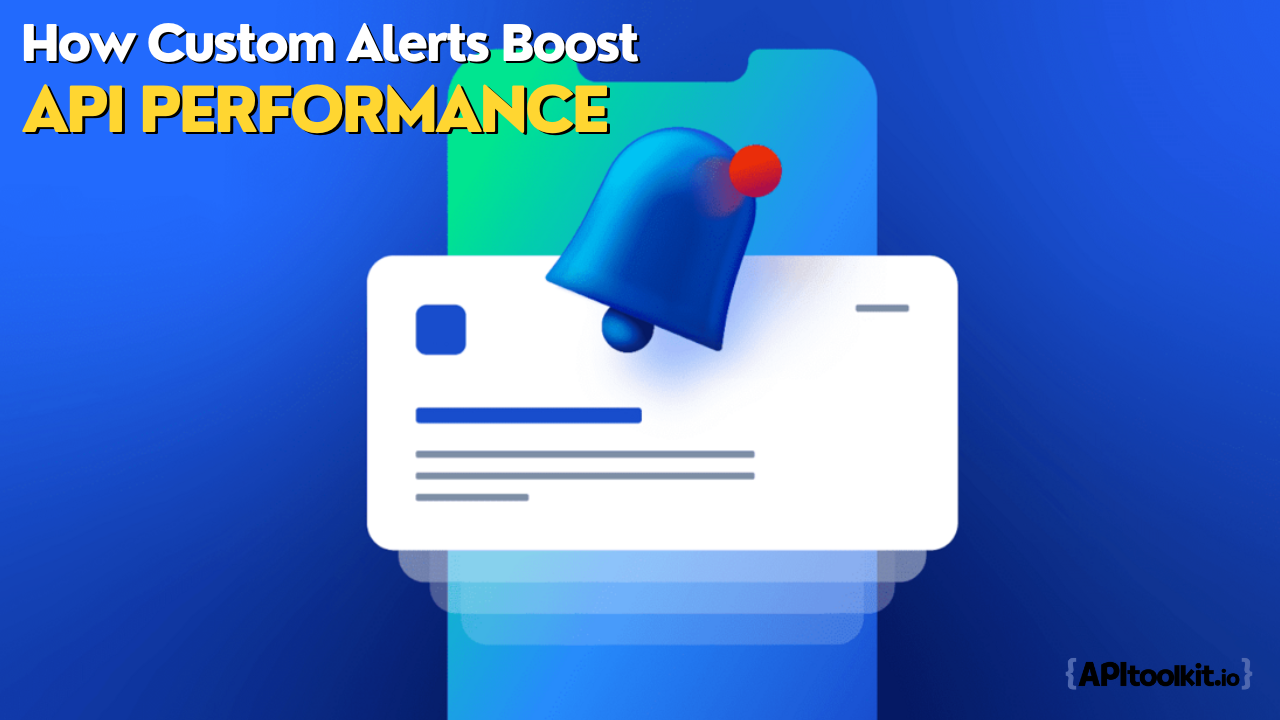How Custom Alerts Boost API Performance for Businesses and Developers

Application Programming Interfaces (APIs) play a vital role in enabling seamless communication between different software systems. However, the growing complexity of digital ecosystems presents challenges such as slow response times, errors, and unexpected outages for businesses and developers.
Addressing these challenges is crucial, and custom alerts emerge as a key solution. This article explores how custom alerts can transform API performance and benefit both businesses and developers.
Custom Alerts
Custom alerts revolutionize API performance monitoring by offering a unique level of granularity. Unlike generic monitoring tools, custom alerts allow users to set specific criteria for monitoring, ensuring a more accurate and targeted approach to performance monitoring.
Key Features of Custom Alerts:
-
Granularity: Users can define specific criteria for monitoring, enabling a detailed examination of API usage patterns and performance metrics.
-
Actionable Insights: Custom alerts go beyond signaling a problem, providing clear information about the issue and potential causes, enabling swift and informed action.
-
Custom Integration: Seamless integration with existing monitoring systems ensures businesses and developers can leverage their current infrastructure while enhancing it with tailored monitoring capabilities.
Components of Custom Alerts
Setting up custom alerts involves defining specific criteria and monitoring parameters. Businesses can tailor alerts based on API usage patterns and incorporate business-specific requirements for a more personalized approach.
A. Defining Custom Alert Criteria
-
Setting Thresholds: Businesses can set thresholds based on their unique API usage patterns, triggering alerts when performance deviates from the expected norm.
-
Incorporating Business-Specific Requirements: Alerts can align with business priorities, considering peak usage times, critical transactions, or specific user segments.
B. Real-Time Monitoring with Custom Alerts
-
Continuous Monitoring: Custom alerts facilitate continuous monitoring, enabling immediate issue detection.
-
Alert Triggers and Escalation Procedures: Well-defined triggers and escalation procedures ensure prompt notification of the right individuals or teams, streamlining issue resolution.
Benefits for Businesses
Custom alerts offer numerous advantages for businesses aiming to optimize API performance.
-
Improved User Experience: Swift issue detection and resolution contribute to enhanced user experiences.
-
Reduced Costs: Proactive issue detection minimizes downtime and lost revenue, reducing the financial impact of API performance issues.
-
Enhanced Brand Reputation: Reliable APIs positively impact brand reputation, building trust and loyalty with users.
-
Increased Operational Efficiency: Streamlined troubleshooting allows teams to operate more efficiently and allocate resources strategically.
Benefits for Developers
Developers also benefit significantly from custom alerts in API management.
-
Faster Development Cycles: Custom alerts reduce debugging time, enabling quicker issue identification and resolution.
-
Improved Code Quality: Alerts provide insights into areas for optimization, resulting in higher code quality and more robust software.
-
Proactive Problem Solving: Custom alerts empower developers to address issues before they impact users, enhancing overall reliability and stability.
-
Increased Development Efficiency: With custom alerts handling monitoring and issue detection, developers can focus more on building features and enhancing functionality.
Best Practices for Implementing Custom Alerts
Successfully implementing custom alerts requires a strategic approach. Consider these best practices:
-
Define Clear Performance Goals: Articulate clear performance goals and Key Performance Indicators (KPIs) for your APIs for effective monitoring.
-
Choose the Right Alerting Platform: Select an alerting platform that aligns with your needs and budget, ensuring seamless integration with your existing infrastructure.
-
Set Up Relevant Thresholds: Establish thresholds and trigger conditions relevant to your specific API and business requirements.
-
Ensure Proper Notification Channels: Guarantee that alerts reach the right team members through appropriate notification channels for a swift response.
-
Regularly Review and Adjust: APIs evolve, so should your alerting strategy. Regularly review and adjust custom alerts to ensure optimal effectiveness.
Choosing the Right Monitoring Tools
1. Seamless Integration: Compatibility with your existing systems is paramount. Tools that integrate smoothly with your API management platforms and frameworks minimize disruption and simplify the setup process.
2. Scalability for Growth: As your API usage and infrastructure evolve, your monitoring solution should adapt seamlessly. Opt for tools that scale alongside your system, ensuring consistent and reliable monitoring even as demands increase.
3. User-Friendly Interface: A clear and intuitive interface empowers both technical and non-technical users to navigate the platform effectively. This fosters collaboration and informed decision-making across your team.
4. Customizable Alerts: Granular control over alert configurations allows you to define specific criteria and thresholds for notifications. This ensures you receive actionable alerts only for situations that truly require attention, reducing noise and streamlining response times.
5. Comprehensive Performance Metrics: A rich set of performance metrics is crucial for gaining deep insights into API behavior. Look for tools that provide data beyond basic functionality, enabling you to identify potential bottlenecks and proactively optimize performance for a seamless user experience.
APIToolkit excels in all these critical areas, making it the ideal choice for robust and efficient API monitoring. It boasts extensive compatibility, effortless integration, and a user-friendly interface accessible to all. APIToolkit scales seamlessly with your growth, offers customizable alerts for focused attention, and provides comprehensive performance metrics for proactive optimization.
By prioritizing these essential qualities and leveraging the capabilities of APIToolkit, you can ensure the continued health and performance of your APIs, fostering a positive user experience and driving business success.
Conclusion
In the ever-evolving digital landscape, API performance is critical for the success of businesses and developers. Custom alerts provide a tailored approach to monitoring, offering actionable insights, seamless integration, and real-time monitoring. They empower businesses to enhance user experiences, reduce costs, and fortify brand reputation. For developers, custom alerts translate to faster development cycles, improved code quality, and proactive problem-solving.
Keep Reading
Incident Management: How to Resolve API Downtime Issues Before It Escalates
How to Generate Automated API Documentation
A Guide to Embedded API Logs and Metrics